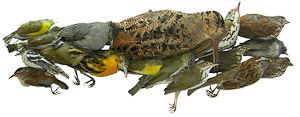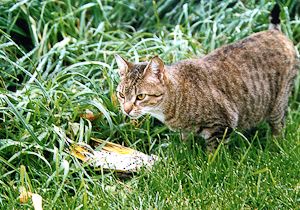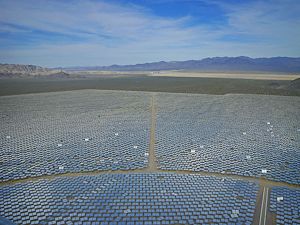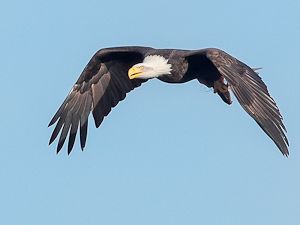

Renewable energy provides an abundance of benefits: few carbon dioxide emissions, improved air quality, and the economic promise of new jobs. But even the most well-intentioned technologies can have unintended drawbacks.
Some 200,000 birds, or more, are killed each year in the United States in collisions with wind turbines (see for example the study conducted by Smallwood). Migrating bats also have difficulty with spinning turbine blades, with tens of thousands of bats dying because of wind towers annually.
Yet birds and bats certainly would not fare well without turbines or other sources of clean energy. More than half of the bird species in the U.S. are under threat from habitat loss due to climate change, according to the Audubon Society’s September 2014 Birds and Climate Change Report. Removing wind turbines and other renewables would lead to greater consumption of fossil fuels, and add to the carbon dioxide emissions that contribute to climate change. Countless species, including birds, would see their habitats change or disappear as the world continues to heat up.
To resolve this dilemma, many bird and bat conservation groups have called on the renewable energy sector to go beyond clean and become super-green. But pushing for tougher standards for wind and other renewables has led to accusations that these activists do not support renewable energy.
‘One of Our More Controversial Programs’
The American Bird Conservancy (ABC) is the only major U.S.-based nonprofit focused on conserving bird species and habitat throughout the Americas. According to ABC, a “(c)omprehensive global energy policy that reduces the burning of fossil fuels is key” to reducing the threat of climate change. “This includes both reducing consumption and developing renewable energy sources on a large scale.”
At the same time, ABC launched its Bird Smart Wind Energy Campaign to push for mandatory bird-friendly standards for industrial wind turbines.

ABC estimates bird mortality from wind turbines closer to half a million per year. Hutchins said 200,000 deaths is at the low end of mortality estimates. A study published in the Wildlife Society Bulletin in 2013 estimated that wind farms led to as many as 570,000 bird and 880,000 bat deaths in the United States in 2012. The study, however, relied in part on bird mortality statistics at the Altamont Pass Wind Resource Area in California. One of the oldest wind farms in the United States and located along a major migratory bird route, Altamont has a higher bird mortality rate than most modern wind facilities, especially for golden eagles. The facility in recent years has worked to replace many of its smaller turbines with fewer, larger turbines, thus providing more space for birds, including eagles, to pass through.
One-Thousandth of One Percent
ABC’s bird-smart program is controversial, in part, because there is controversy over the significance of the number of bird deaths from wind turbines.
There are an estimated 10 to 20 billion birds in the United States, although the number fluctuates throughout the year. Worldwide, estimates put the total at 200 to 400 billion birds. The loss of 200 thousand in a population of 20 billion is relatively small: one-thousandth of one percent of the population.

The common house cat kills 1.4 to 3.7 billion birds each year in the U.S. alone, according to estimates from ABC. The low end of that estimate—1.4 billion—is roughly equal to the human population of China. Add in dangers from transmissions lines and collisions with windows and communication towers, and the number of birds killed from wind turbines becomes just a small fraction of human-related causes of bird mortality, AWWI said in its 2014 review of bird and bat mortality studies.
AWWI was formed in 2009 to promote wind energy as well as wildlife and habitat conservation. Members include the Audubon society, the Nature Conservancy, National Wildlife Federation, and the Union of Concerned Scientists, as well as industry groups such as GE, Duke Energy, and BP Wind Energy.
Broad Support for Wind Energy
Many mainstream environmental groups support wind energy, according to David Ward, deputy director of strategic communications for the American Wind Energy Association. On the other hand, said Ward, it would be hard to find a wind project that ABC has supported.
ABC is one of the most “stridently wind-suspicious of the major bird organizations,” notes Mike Barnard, a Senior Fellow specializing in Wind for the Energy and Policy Institute. “They routinely publish outlier numbers as fact and, much more frequently than other organizations, attack wind siting from a national level.”
Miles Grant, senior communications manager for the National Wildlife Federation, said siting issues and determining the best location for wind farms are critical issues that need to be resolved. “We need to sort them out and not be an impediment.”
Grant also cautioned against making generalizations, saying it is important to look at all aspects involved in each individual project.
Act While the Problem is Solvable
There are many things killing birds, acknowledged ABC’s Hutchins: pesticides, cats, windows. “Now we have wind. We should focus on all of them.” Wind turbines are killing birds, and wind power is expected to continue to grow. He added, “Now is the time to act, while the problem is solvable.”
About 10 percent of energy consumed in the U.S. in 2013 came from renewable sources, according to the U.S. Energy Information Administration (EIA). Renewable sources include hydropower, geothermal and biomass as well as wind and solar power. EIA also expects the share of renewable energy sources to continue to grow as the U.S. and much of the rest of the world try to reduce their carbon dioxide emissions.
In addition, the total number of bird deaths is not the only significant factor. Wind turbines and other renewables often have a greater impact on particular species. The death of 1,000 sparrows may comprise only a very small percentage of the species’ population. But the loss of 1,000 golden eagles or 1,000 tree bats could be more significant, especially for localized populations.
Many raptors are more at risk from wind turbines, according to Hutchins, while waterfowl are not heavily affected. Bald eagles currently are little affected by land-based turbines, but risks to our national bird could increase if offshore farms are installed along the eagles’ migratory routes.
Wind turbines also may affect local habitats. There are concerns that some birds, such as sage grouse and prairie chickens, may view wind turbines as potential perches for predators, and thus avoid areas where they might otherwise nest or forage for food.
A number of nonprofit groups focused on particular species have joined with ABC to oppose some projects. The International Crane Foundation joined with ABC to send a letter to the U.S. Fish and Wildlife Service expressing concern about the Merricourt wind project in North Dakota. The facility would be located near the migration routes of several protected species, including the whooping crane and piping plover.
Solar Projects Also Pose Hazards
Large solar arrays also pose a hazard to many birds and other animals, Hutchins said. Traditional photovoltaics, or PVs, use semiconductors to convert sunlight directly into electricity. Hundreds of solar panel arrays must be arranged side by side to generate utility-scale electricity. This creates “an evolutionary trap” for many birds, according to Hutchins, because the arrays look like a body of water. Birds are injured or killed when they dive down and crash into the panels.

The large size of industrial-scale solar arrays can also impact the habitat of local wildlife, degrade local vegetation, and interfere with rainfall and natural drainage, according to the U.S. Department of Energy.
The Ivanpah solar array takes up more than five square miles of land, about four times the size of New York City’s Central Park. Cumulative impacts from the Ivanpah project and related development covering that much land area could negatively affect the desert tortoise and local nesting birds, and could increase the presence of noxious weeds, according to the Final Environmental Impact Statement prepared by the federal Bureau of Land Management.
These large-scale enterprises are different from small-scale or distributed solar projects, such as residential rooftop PV panels. Large-scale solar projects have seen irregular growth in recent years, while residential solar projects have seen a slow but steady increase. In the first three months of 2014, residential PV installations exceeded new commercial installations, according to the Solar Energies Industry Association. SEIA also predicts that the residential solar market could be larger than the commercial market as early as 2016.
Small-scale solar power offers an advantage in that it produces electricity right where it will be consumed. But small projects also can be more expensive per watt produced than large, utility-scale arrays. In addition, many homes are not optimally oriented to capture sunlight. Large-scale arrays, on the other hand, can be built in areas where sunlight is most optimal.
Unfair to Focus on Technology?
Perhaps it is unfair to focus on wind energy or the effects of any technology. After all, two common themes that link wind towers, windows, and house cats are their centrality to human life and their unanticipated consequences for birds and other wildlife.
Today cats, both domesticated and feral, are found in nearly every corner of the world where there are humans. They also have a tremendous impact on populations of local birds, native predators, and various other species. As a result, cats have been listed as one of the 100 worst invasive species in the world, by the Global Invasive Species Database.
Windows provide a variety of benefits: safety and protection from the elements, plus aesthetic beauty, fire resistance, and energy efficiency. While glass allows humans to see the outside world, other animals cannot see the glass itself. Songbirds are most at risk from collisions, but hummingbirds, woodpeckers, even birds of prey often collide with buildings, too.
Bird-Smart Standards
Wind towers were intended to mitigate a central threat to mankind and wildlife: climate change. But even the most seemingly benign advances can have undesirable effects.
ABC has laid out a series of standards designed to reduce bird collisions with wind turbines, Hutchins said. Multiple organizations support various measures to protect wildlife around wind farms, including the Sierra Club, the Center for Biological Diversity, and multiple local chapters of the Audubon Society.
ABC’s bird-smart campaign calls for four main standards for wind turbines: proper siting, improved technology, monitoring, and compensation. Bird-smart siting of wind turbines would place wind farms away from sensitive nesting areas, key migration zones, and wetlands. Improved technology and techniques can also minimize harm to birds. Installing pulsating lights can deter birds from approaching towers, added Hutchins. Some projects also use human spotters to warn a facility to shut down ahead of the approach of large flocks of birds.
Such steps can also help to reduce the negative effects on bats. Bat Conservation International is working to reduce bat fatalities through better wind farm operating techniques. Adjusting turbine operations and incorporating ultrasonic acoustic deterrents have helped to reduce bat kills by as much as 93 percent in some areas.
Bird-smart wind power should also include pre-construction assessments to quantify potential impacts, as well as post-construction monitoring. Following the loss of birds or their habitat caused by the operation of wind farms, compensation should be made in the form of land for conservation or wildlife habitat, according to ABC.
As for solar energy, Hutchins said more research is needed to develop better techniques for solar facilities. There is also a need to develop a way to make solar arrays look less like bodies of water that can attract migrating birds.
Federal Guidelines Encourage Monitoring, Research
Federal guidelines exist to protect birds and other species. The guidelines call for “rigorous” monitoring and research, as well as efforts to minimize bird deaths and compensation for adverse effects on species and habitat. Adherence to the guidelines is voluntary.

In 2013, the Interior Department issued a rule allowing operators of wind farms to receive permits to kill or otherwise harm eagles for up to 30 years so long as they adopt measures designed to minimize the harm to eagles.
The federal guidelines are too weak, according to ABC’s Hutchins. ABC and several other environmental groups disagree with the 30-year take rule. All reporting of bird mortality is based on self-reporting, Hutchins said. This leaves “the fox watching the henhouse,” he said.
Climate Change the Overarching Threat
Despite the tension within some sectors of the environmental community, the primary focus for most remains climate change. “Climate change is the biggest threat wildlife will face this century,” the National Wildlife Federation stated in a 2013 report. Audubon’s 2014 report highlighted specific threats to more than half of the species of birds in the United States. According to ABC, climate change “has risen to become one of the top environmental issues in the public's consciousness.”
While ABC has ruffled some feathers in the renewable energy sector, particularly among wind energy advocates, all groups involved share a similar goal: minimizing the impacts of climate change on wildlife and habitat.
Climate change, or at least an accelerated change in climate, was itself an unintended byproduct, the result of an excess of carbon dioxide and other gases emitted from the technology that powers and enriches our lives. As we shift to cleaner, renewable sources of energy to both improve our lives and our planet, it is important to consider the possible negative consequences and to avoid creating new problems to solve.
Video of a bird strike
Photos are copyright protected and may not be reproduced without permission. Copyright information for the photos is as follows: (1) Ardrossan Wind Farm, courtesy of Vincent van Zeijst, Eagle, photo courtesy of American Bird Conservancy (2) Birds killed in collisions, photo by Daniel Lebbin of American Bird Conservancy (3) Cat with flicker, photo by Marge Gibson, courtesy of American Bird Conservancy (4) Ivanpah Solar Electric Generating System, photo courtesy USFWS (5) Ingrid Taylar, On approach, requesting permission to land. With fish (bald eagle) photo courtesy Ingrid Taylar